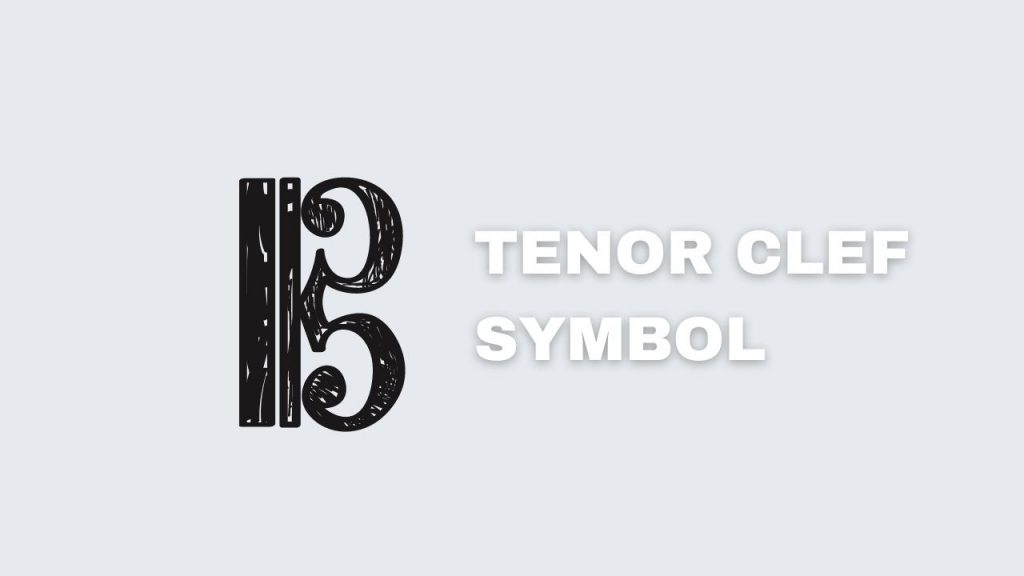Tenor clef is one of the most common types of musical notation. It’s the fourth clef in order, and it tells you which notes get played by the tenor part of the choir. But, don’t worry! It is the easiest to read because it has fewer lines than other clefs, and you can find it in both treble and bass clef.
Tenor Clef: What Is It?

This clef is a type of musical symbol that is used to notate the tenor voice. The clef has two lines on each side of the four-line staff, as shown above.
Writing your music in tenor typically sounds lower than music written in bass or treble clef. There are many tenors, including soprano and alto, but they all sound about an octave lower than their corresponding voices.
Some think tenors sing at the same pitch as baritones or mezzo-sopranos because they’re so much higher than women’s voices. People also refer to Tenors as a countertenor by singers who can sing tenor and alto, but tenor is the more common term. In modern music, tenors sing most tenor parts. In choir situations, tenors usually form the tenor section right in front of the conductor.
Why Does the Tenor Clef Exist?
The clef is an indication of the pitch range that it covers. Its range starts at tenor C and goes to tenor B, about two octaves below middle C or four octaves below the treble clef’s top line. This is because tenors get expected to sing notes in the lower register of a song.
The tenor is best for singers who play instruments (such as violins) to know where they should be playing their parts on their device without singing along with them.
How Do You Identify a Tenor Clef?
Tenor clef is one of the most common clefs in the Western Classical Music genre. The clef has two vertical lines on either side of a line going from left to right. These lines are called “clefs.” The top line indicates what note should get played as middle C or doh. The bottom line suggests what note should get played as B-flat or “si flatte.”
To read tenor clef notes correctly, you must know where middle C and B-flat are on the staff. This way, you can place your finger there when reading music in tenor. Another way to identify a piece of music written in clef is by looking at the key signature. Here are some tips to identifying clefs:
If:
- It as one sharp, then it’s E-flat major or F major.
- There are two sharps, then it’s A major or G major.
- There is no sharp sign, you must look at middle C’s line.
- It’s an A, B, C, D, E, F, or G, then you’re looking at a piece of music in either G major or F major.
What Instrument Reads Tenor Clef?
The tenor saxophone is a woodwind instrument, similar to an alto sax or baritone horn. The term “tenor” refers to the compass of notes it plays and the range in which those notes are played.
- The alto saxophone reads this type of music because its range goes from Bb3 to G6.
- The viola reads these types of music because its range starts at A2 and goes as high as D7 on some occasions.
- And all other wind instruments read these types of music because their ranges are between those two points in either direction — higher or lower than those two points, respectively.
The tenor saxophone can play from any note between E2 and C6 (the same range as a viola). In other words, it can play everything from middle-C up to three octaves above it.
Some musicians also refer to this instrument as a “baritone” because its lowest register sounds more like a bari sax. But no matter what you call it, the tenor sax is one of the most versatile instruments around.
Conclusion
In conclusion, the treble clef is written two octaves lower than the regular treble clef. The tenor part shares some similarities with bass and baritone parts in that they are all low-pitched instruments.
But unlike those other voices, which read their respective notes on the same line as each other, this voice splits up its range among two lines to give more space for higher-pitched instruments like violins or flutes. This makes it easier for these high-range players to play alongside tenors without getting mixed up.
Table of Contents






